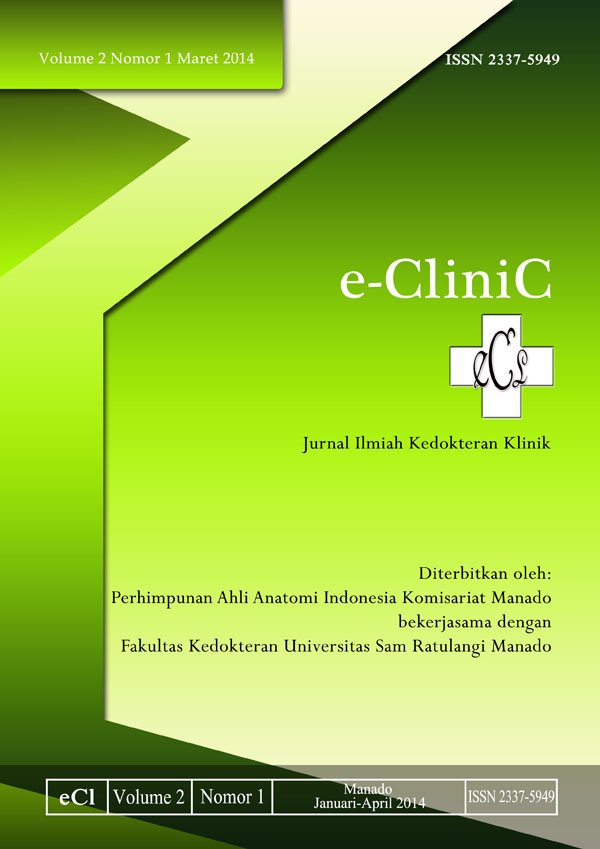PROFIL DERMATITIS KONTAK DI POLIKLINIK KULIT DAN KELAMIN BLU RSUP PROF DR. R. D. KANDOU MANADO PERIODE JANUARI – DESEMBER 2012
DOI:
https://doi.org/10.35790/ecl.v2i1.3602Abstract
Abstract: Contact dermatitis is a skin inflamatory response caused by direct contact with materials or particular substances. Contact dermatitis is classified into two types: irritant contact dermatitis (ICD) which is a non-immunologic response and allergic contact dermatitis (ACD) which is caused by immunologic mechanisms, type IV hypersensitivity reaction. This study aimed to evaluate the profile of contact dermatitis in patients of Dermatovenereology clinic at Prof. Dr. R. D. Kandou Hospital Manado during the period from January 2012 – December 2012. This was a retrospective study of 77 medical records of new patients with contact dermatitis based on number of patients, age group, sex, occupation, affected location, causes, and treatment used. The results showed that among 77 new patients with contact dermatitis, the highest age group was 45-64 years (37.7%), more often in female (67.5%), most frequent occupation was homemaker (24.7%), most location affected was leg (26%), most common causes were detergent and rubber (13%), and the most therapy used was a combination of corticosteroid and antihistamine (42.8%). Conclusion: Among patients of Dermatovenereology clinic at Prof. Dr. R. D. Kandou Hospital Manado contact dermatitis was most frequently found in age group 45-64 years, female gender, and occupation as house wife. Leg was the most affected site, detergent and rubber as the main causes, and combination therapy as the most frequent therapy used.
Keywords: contact dermatitis
Â
Â
Abstrak: Dermatitis kontak adalah peradangan kulit sebagai respon terhadap bahan atau substansi tertentu yang berkontak dengan kulit. Dermatitis kontak diklasifikasikan menjadi 2 bagian besar, yaitu dermatitis kontak iritan (DKI) yang merupakan respon non imunologik dan dermatitis kontak alergi (DKA) yang diakibatkan oleh mekanisme imunologik, reaksi hipersensitivitas tipe IV. Penelitian ini bertujuan untuk mengetahui profil pasien dermatitis kontak di Poliklinik Kulit dan Kelamin RSUP Prof. Dr. R. D. Kandou Manado periode Januari 2012 – Desember 2012. Penelitian ini merupakan penelitian retrospektif dari 77 catatan medik pasien baru dermatitis kontak berdasarkan jumlah pasien, umur, jenis kelamin, pekerjaan, lokasi, penyebab, dan terapi. Hasil penelitian menunjukkan bahwa dari 77 orang (7,02%) pasien baru yang berkunjung, didapatkan kelompok usia terbanyak 45-64 tahun (37,7%), jenis kelamin perempuan (67,5%), pekerjaan terbanyak ibu rumah tangga (24,7%), lokasi terbanyak yaitu kaki (26%), penyebab terbanyak ialah detergen dan karet (13%), serta terapi yang terbanyak digunakan kortikosteroid dan antihistamin (42,8%). Simpulan: Pada pasien dermatitis kontak di Poliklinik Kulit dan Kelamin RSUP Prof. Dr. R. D. Kandou Manado yang terbanyak kelompok usia 45-64 tahun, jenis kelamin perempuan, pekerjaan ibu rumah tangga, lokasi tersering kaki, penyebab tersering deterjen dan karet, serta pemberian terapi tersering ialah kombinasi kortikosteroid dan antihistamin
Kata kunci: dermatitis kontak
Downloads
How to Cite
Issue
Section
License
COPYRIGHT
Authors who publish with this journal agree to the following terms:
Authors hold their copyright and grant this journal the privilege of first publication, with the work simultaneously licensed under a Creative Commons Attribution License that permits others to impart the work with an acknowledgment of the work's origin and initial publication by this journal.
Authors can enter into separate or additional contractual arrangements for the non-exclusive distribution of the journal's published version of the work (for example, post it to an institutional repository or publish it in a book), with an acknowledgment of its underlying publication in this journal.
Authors are permitted and encouraged to post their work online (for example, in institutional repositories or on their website) as it can lead to productive exchanges, as well as earlier and greater citation of the published work (See The Effect of Open Access).







